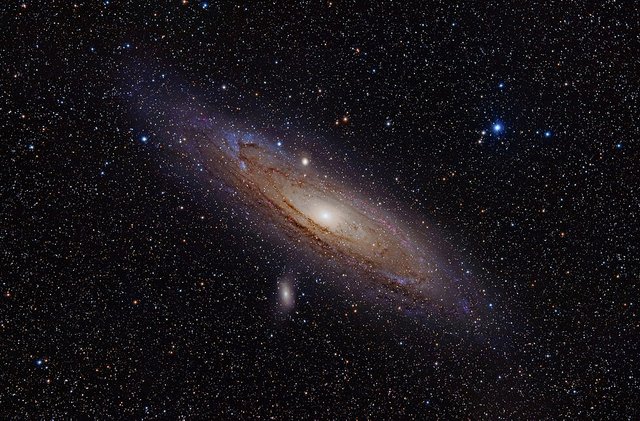
The Andromeda Galaxy. Image source: [1]
The galaxy of Andromeda is also known as MESSIER 31, since it is the Messier catalog number object 31 of fuzzy objects in the sky. It is a super giant spiral of the type Sb with a luminosity that is, apparently, something greater than the one of our galaxy. It is turned towards us so that its main plane constitutes an angle of 15 degrees with the line of sight, that is, it is almost in profile. However, a 15-degree angle is not small enough so that the dusty matter near the main plane of this galaxy can manifest itself as a dark belt. Andromeda is 2.5 million light years from us and is the closest spiral galaxy.
Messier 31 is the closest major galaxy to ours, the Milky Way. It is believed that our galaxy looks quite like Andromeda. Together, both galaxies dominate the Local Group of galaxies. The diffused light that comes to us from Andromeda has its origin in the hundreds of billions of stars that form it. The different stars that surround Messier 31.
The peculiar thing about the Andromeda Galaxy is that it approaches ours, the Milky Way, at a speed of 300 kilometers per second. It is believed that within 3,000 to 5 billion years, both could collide. The planets and stars within each galaxy would not collide, but they would alter the orbits and order within each system.
More details here: Messier 31
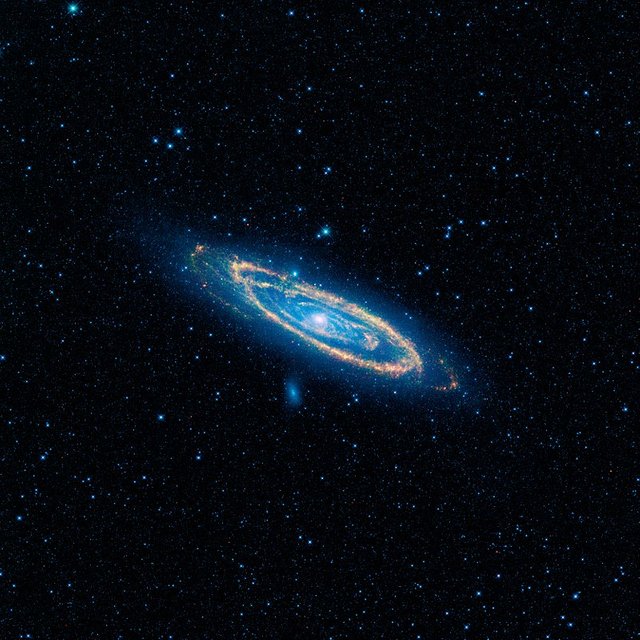
The Andromeda Galaxy as seen by NASA's Wide-field Infrared Survey Explorer. Image source: [2]
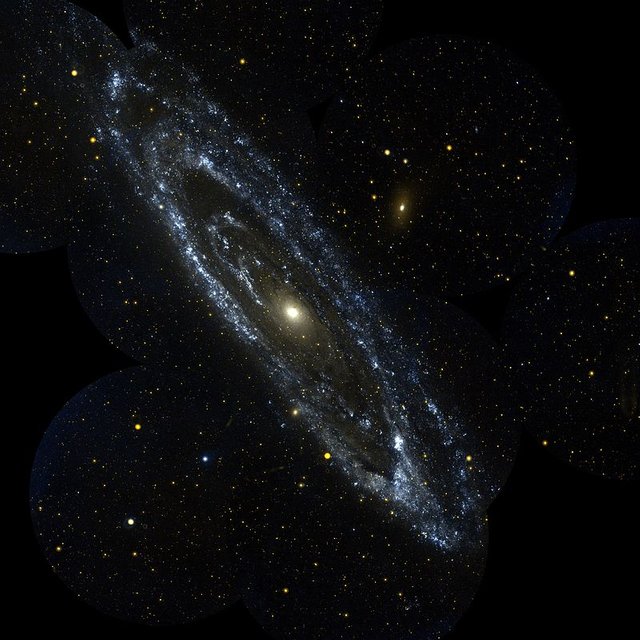
The Andromeda Galaxy pictured in ultraviolet light by GALEX. Image source: [3]
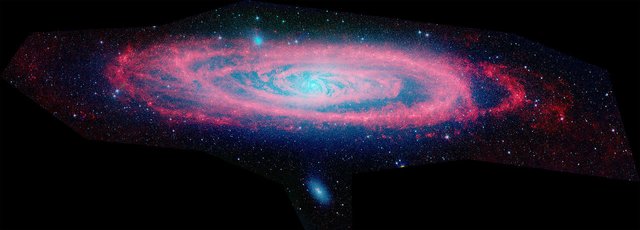
The Andromeda Galaxy seen in infrared by the Spitzer Space Telescope, one of NASA's four Great Space Observatories. Image source: [4]

Image of the Andromeda Galaxy taken by Spitzer in infrared, 24 micrometres (Credit:NASA/JPL–Caltech/K. Gordon, University of Arizona). Image source: [5]
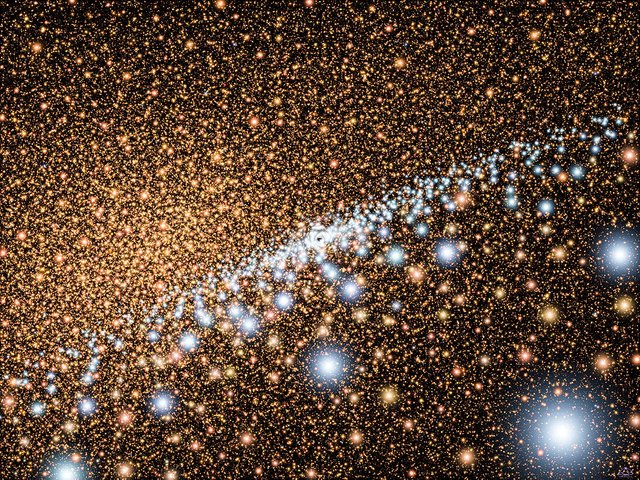
Artist's concept of the Andromeda Galaxy core showing a view across a disk of young, blue stars encircling a supermassive black hole. NASA/ESA photo. Image source: [6]

Excellent post @jonathanxvi. Thanks for sharing!. Regards.
Downvoting a post can decrease pending rewards and make it less visible. Common reasons:
Submit
Looking at those pictures of the Andromeda galaxy really does shift your perspective on things. We are tiny. Imagine the vastness of the cosmos. There has got to be life out there somewhere.
Downvoting a post can decrease pending rewards and make it less visible. Common reasons:
Submit
Excelente post.
Downvoting a post can decrease pending rewards and make it less visible. Common reasons:
Submit
I remember my astronomy teacher back in university talking to us about Andromeda.
Good post, with plenty of references for further studying ;)
Downvoting a post can decrease pending rewards and make it less visible. Common reasons:
Submit
Nice space
Downvoting a post can decrease pending rewards and make it less visible. Common reasons:
Submit
Thanks :D
Downvoting a post can decrease pending rewards and make it less visible. Common reasons:
Submit
Informative post. Thank you :)
Downvoting a post can decrease pending rewards and make it less visible. Common reasons:
Submit
My favorite one.
Upvoted
Downvoting a post can decrease pending rewards and make it less visible. Common reasons:
Submit
Awesome photo
Downvoting a post can decrease pending rewards and make it less visible. Common reasons:
Submit
AMAZING
Downvoting a post can decrease pending rewards and make it less visible. Common reasons:
Submit
Absolutely gorgeous! More pics of galaxies please...to keep things in perspective:). Thank you!
Downvoting a post can decrease pending rewards and make it less visible. Common reasons:
Submit
very good posting , thanks for sharing it ;
Downvoting a post can decrease pending rewards and make it less visible. Common reasons:
Submit
Amazing post Follow me @muna17
Done
Downvoting a post can decrease pending rewards and make it less visible. Common reasons:
Submit
Wow my friend, congratulations, this is a excelent post, thanks for the information
Downvoting a post can decrease pending rewards and make it less visible. Common reasons:
Submit
Congratulations, your post received one of the top 10 most powerful upvotes in the last 12 hours. You received an upvote from @curie valued at 62.22 SBD, based on the pending payout at the time the data was extracted.
If you do not wish to receive these messages in future, reply with the word "stop".
Downvoting a post can decrease pending rewards and make it less visible. Common reasons:
Submit
Very beautiful! :)
Downvoting a post can decrease pending rewards and make it less visible. Common reasons:
Submit
Cool!
Maybe the two galaxies will form a binary galaxy, similar to a binary stars that orbit each other? Or perhaps they already are??
Or because the gravitational pull of the black hole at the center of the Milky Way and Andromeda (not to mention all the additional matter in our galaxy) are enormous and since their is no resistance in space like atmosphere, maybe they will speed up if they are heading towards each other? Kinda like that compounding interest thingy.
Downvoting a post can decrease pending rewards and make it less visible. Common reasons:
Submit
Wonderful post,when people post stuffs like this,we get to learn...thanks for sharing
Downvoting a post can decrease pending rewards and make it less visible. Common reasons:
Submit
Wow nice moment
Downvoting a post can decrease pending rewards and make it less visible. Common reasons:
Submit
Mmmh! reflecting the days in the college
Downvoting a post can decrease pending rewards and make it less visible. Common reasons:
Submit
Excellent @jonathanxvi
https://postimg.org/image/55q2k5anp/96ffe1be/
Downvoting a post can decrease pending rewards and make it less visible. Common reasons:
Submit
Downvoting a post can decrease pending rewards and make it less visible. Common reasons:
Submit